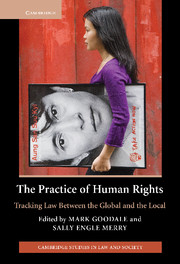Book contents
- Frontmatter
- Contents
- Contributors
- Acknowledgments
- Introduction Locating rights, envisioning law between the global and the local
- PART ONE STATES OF VIOLENCE
- Introduction
- 1 Human rights as culprit, human rights as victim: rights and security in the state of exception
- 2 “Secularism is a human right!”: double-binds of Buddhism, democracy, and identity in Nepal
- PART TWO REGISTERS OF POWER
- PART THREE CONDITIONS OF VULNERABILITY
- PART FOUR ENCOUNTERING AMBIVALENCE
- Conclusion Tyrannosaurus lex: the anthropology of human rights and transnational law
- Index
- References
2 - “Secularism is a human right!”: double-binds of Buddhism, democracy, and identity in Nepal
Published online by Cambridge University Press: 29 March 2011
- Frontmatter
- Contents
- Contributors
- Acknowledgments
- Introduction Locating rights, envisioning law between the global and the local
- PART ONE STATES OF VIOLENCE
- Introduction
- 1 Human rights as culprit, human rights as victim: rights and security in the state of exception
- 2 “Secularism is a human right!”: double-binds of Buddhism, democracy, and identity in Nepal
- PART TWO REGISTERS OF POWER
- PART THREE CONDITIONS OF VULNERABILITY
- PART FOUR ENCOUNTERING AMBIVALENCE
- Conclusion Tyrannosaurus lex: the anthropology of human rights and transnational law
- Index
- References
Summary
A colorful photograph on the cover of the May/June 1994 issue of The Dharmakirti, a Kathmandu-based Buddhist monthly magazine, shows a field of Theravada Buddhist monks marching down a main street in downtown Kathmandu waving flags and carrying banners. Marking the cover of a special issue devoted to the topic of secularism, the scene was readily recognizable to the magazine's Buddhist readers, many of whom had themselves attended the rally where the picture was taken. It was, at that time, the largest political gathering yet seen in Nepal: over 100,000 people reclaimed the streets of the capital to march for the constitutional redefinition of Nepal as a secular state. Clad in their characteristic yellow robes and shaven heads, the stream of monks in the picture stretches as far down the road as the eye can see. A large red banner proclaims their message to the state and the world: “Secularism is a human right!” (Dharmanirapekshanā mānab adhikār ho).
This picture, and the events surrounding it, raise a number of questions for students of transnational politics, religion, and human rights. Why would Buddhist monks – quintessential religious subjects – lead a march in support of secularism? And, given that human rights conventions guarantee freedom of religion, how and why do they make the claim that secularism is a human right?
- Type
- Chapter
- Information
- The Practice of Human RightsTracking Law between the Global and the Local, pp. 78 - 114Publisher: Cambridge University PressPrint publication year: 2007
References
- 17
- Cited by



